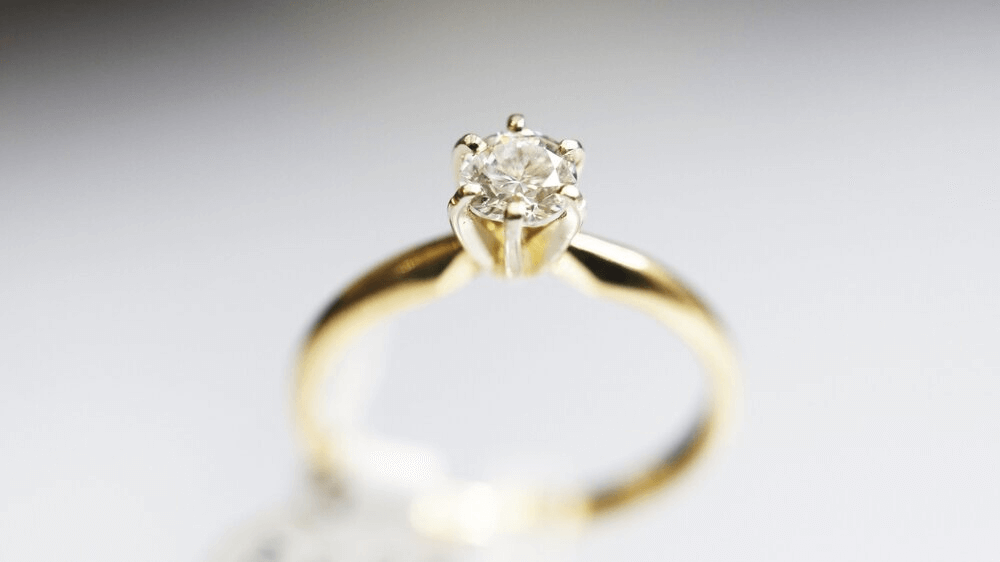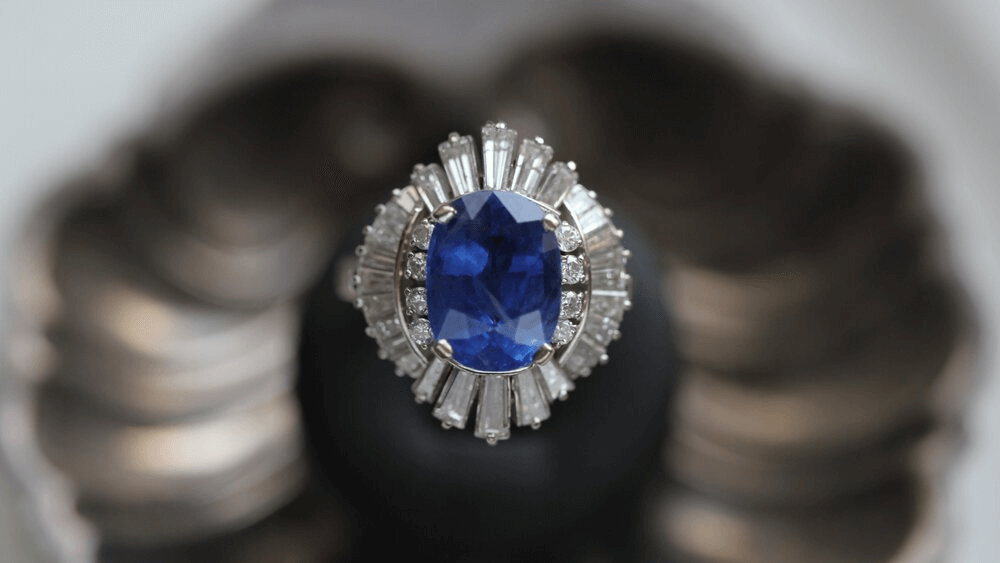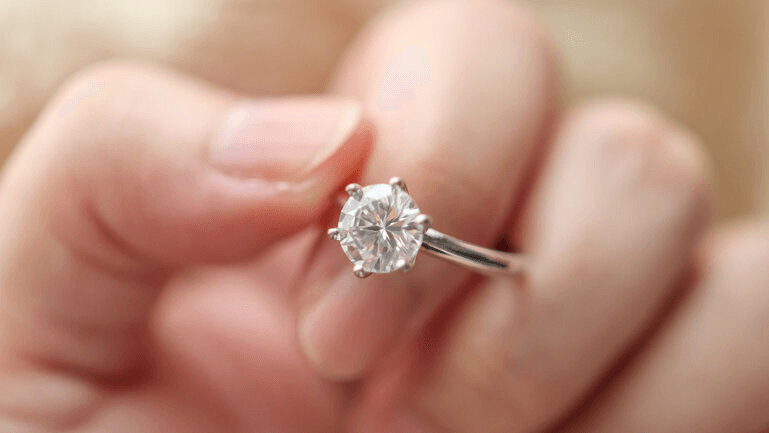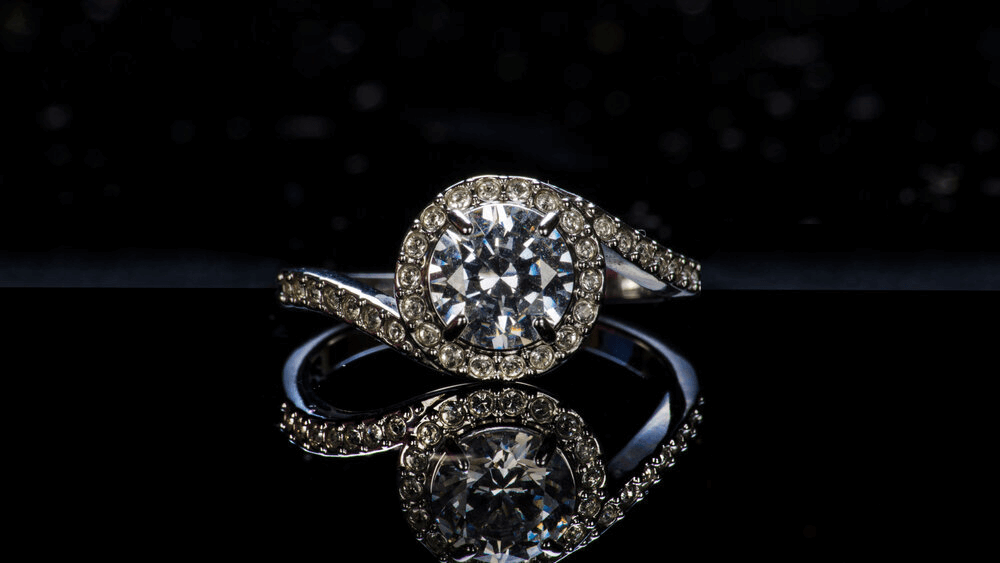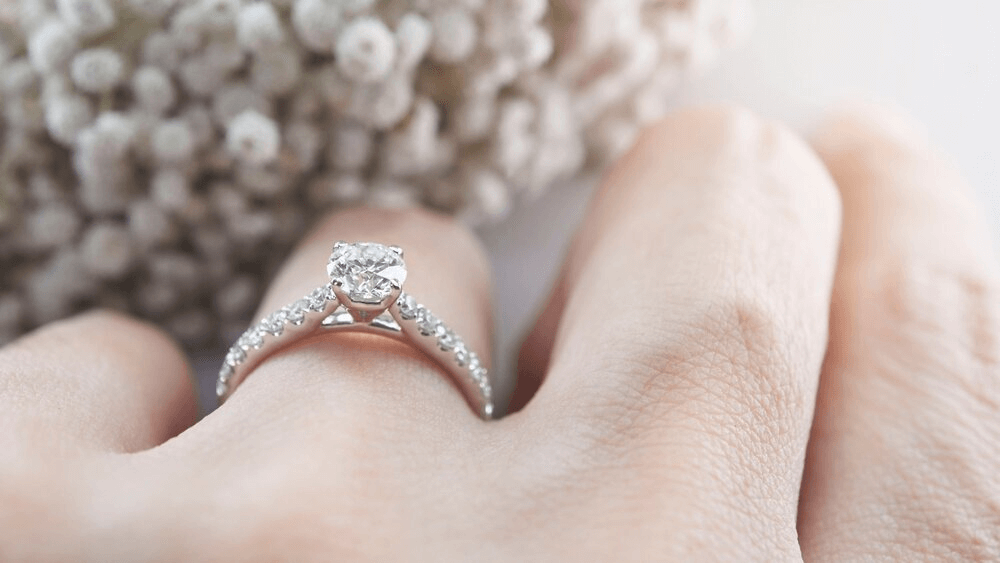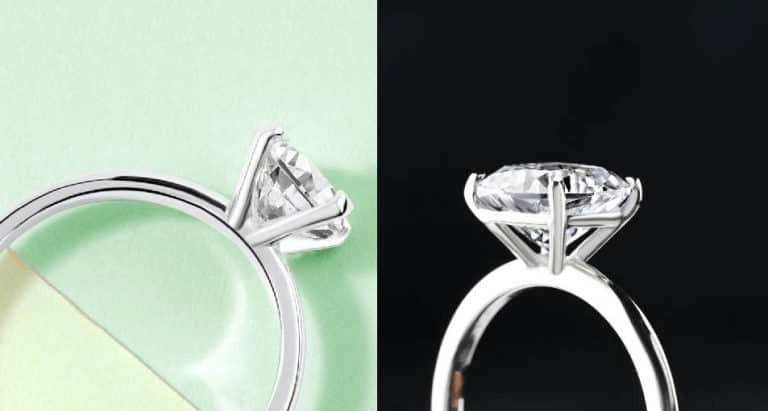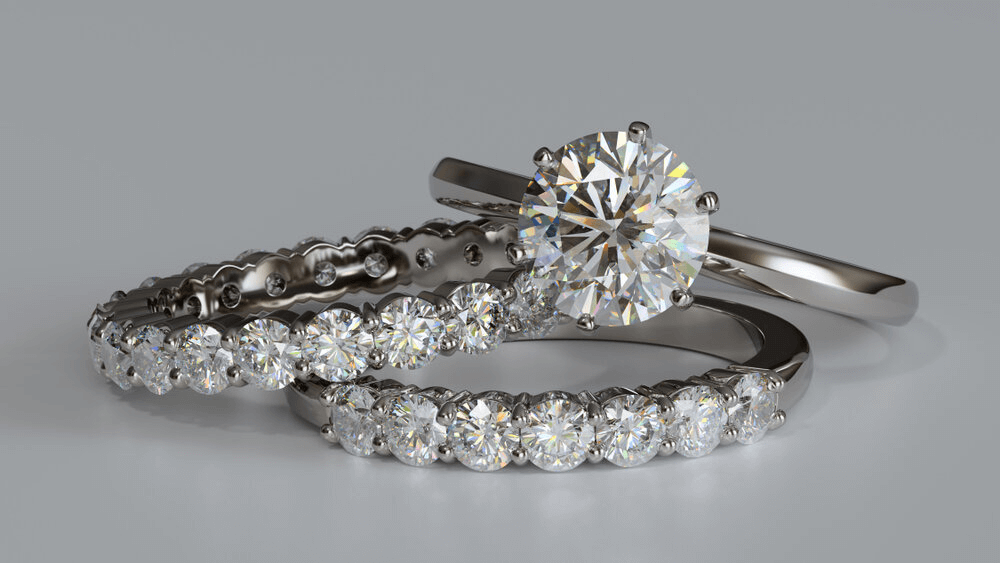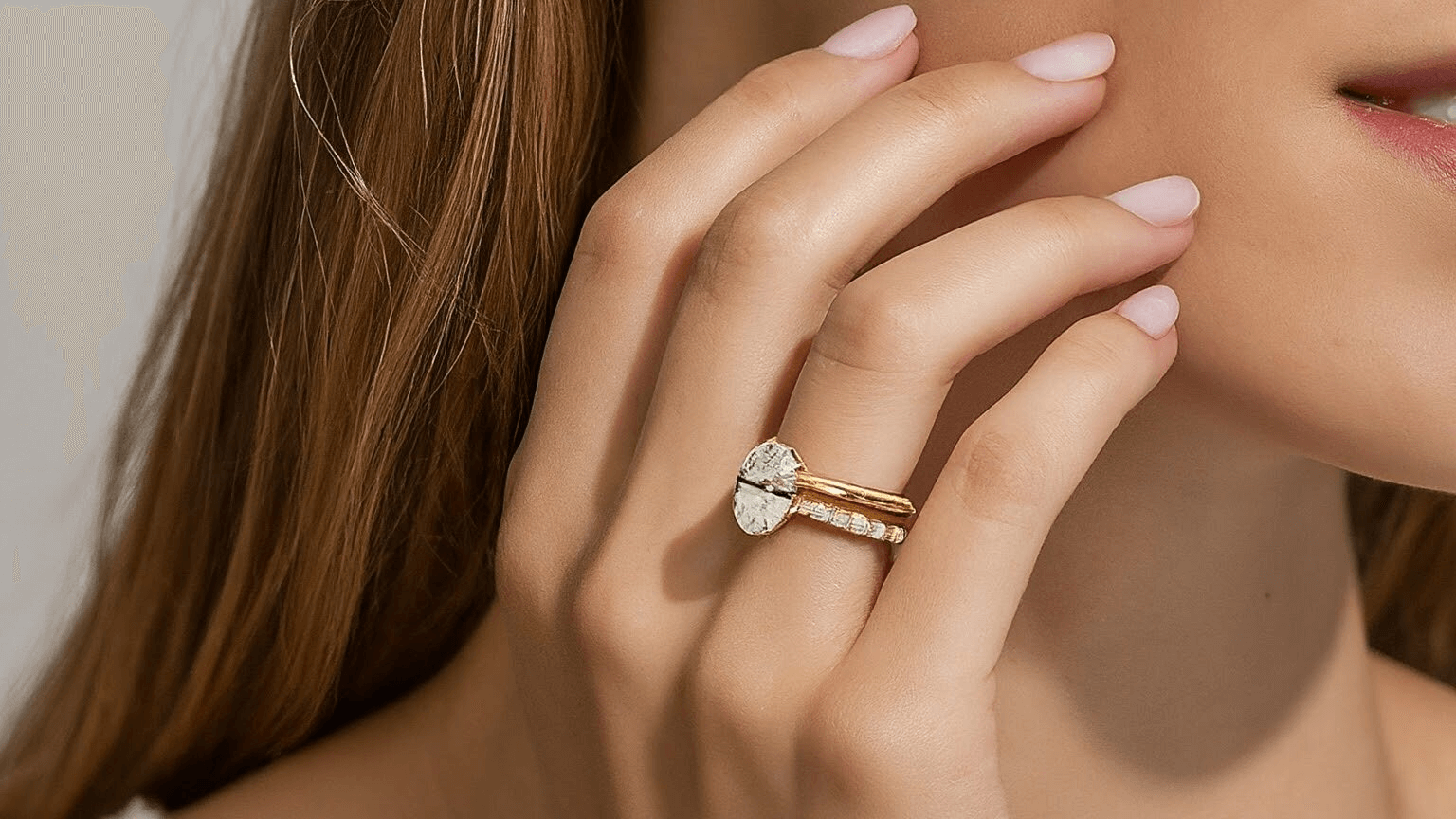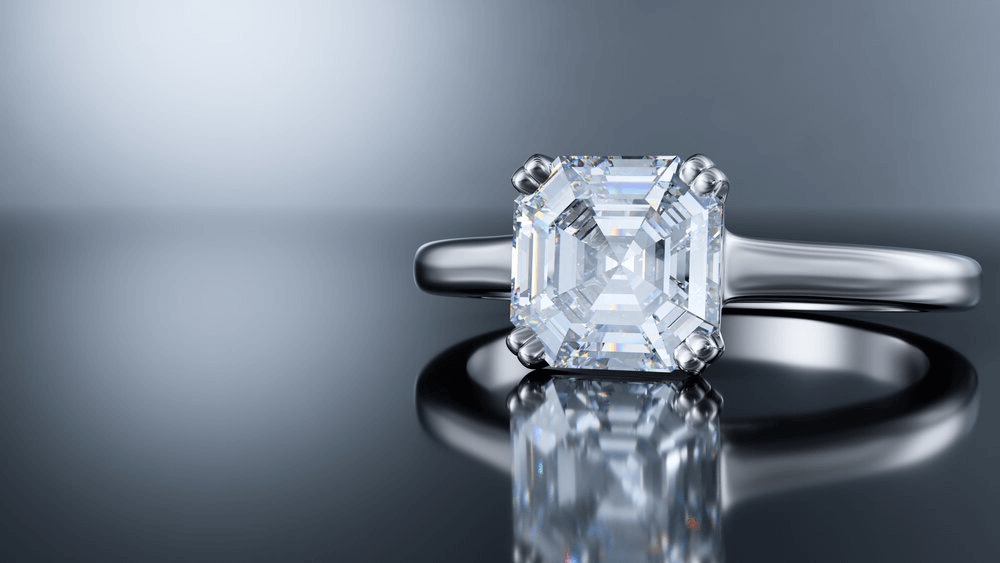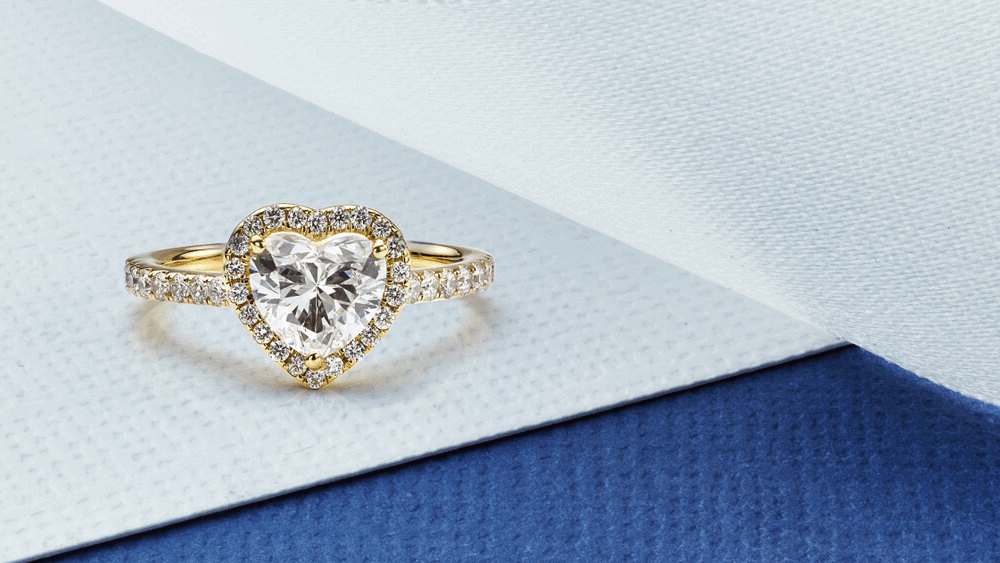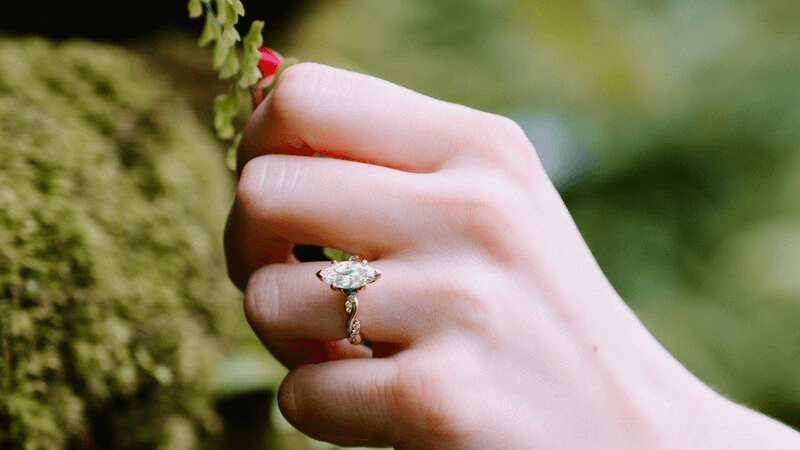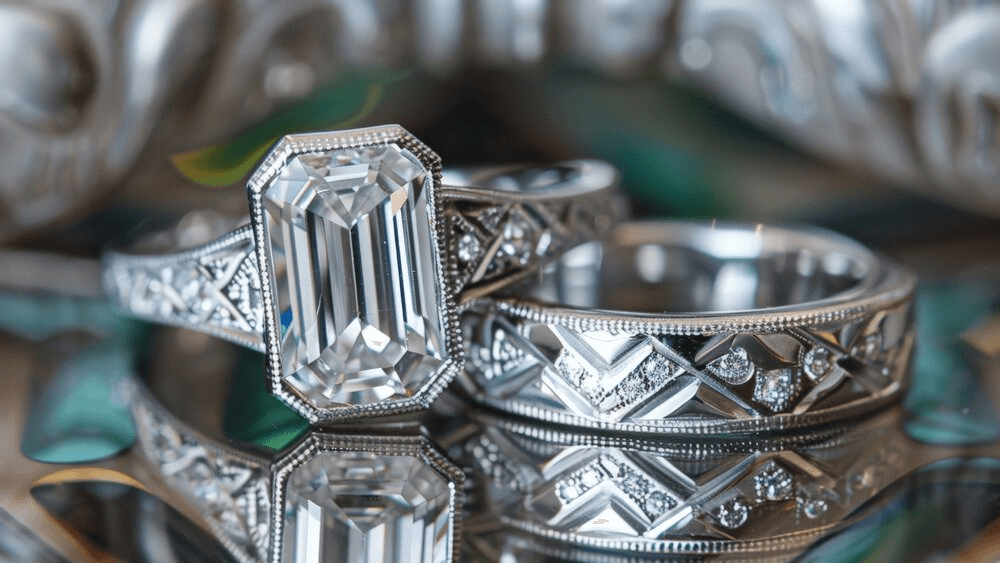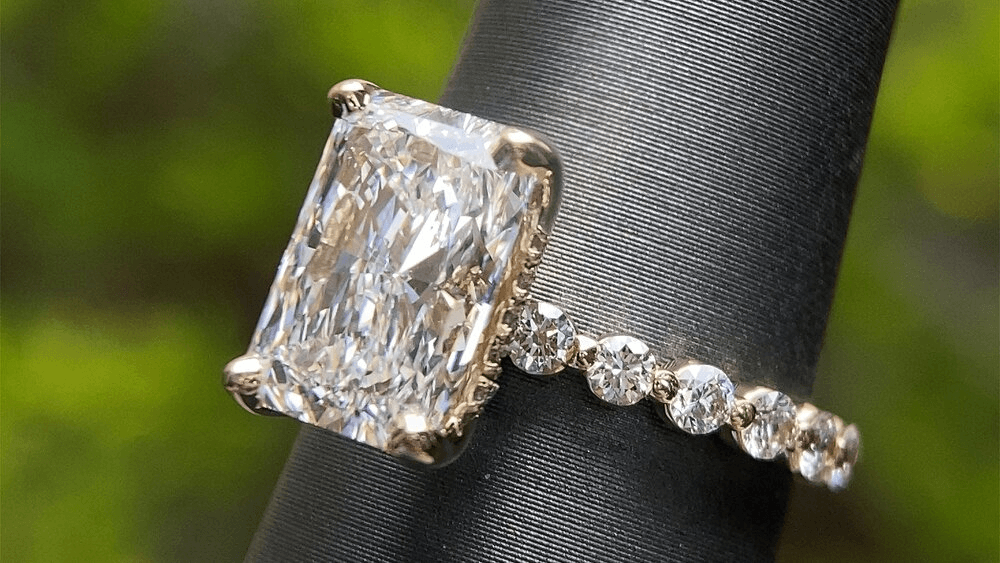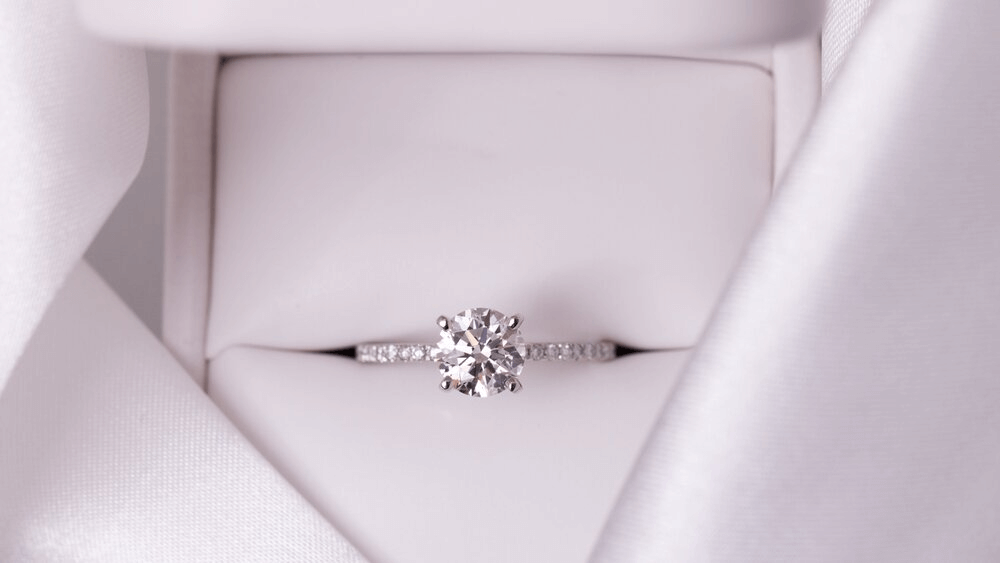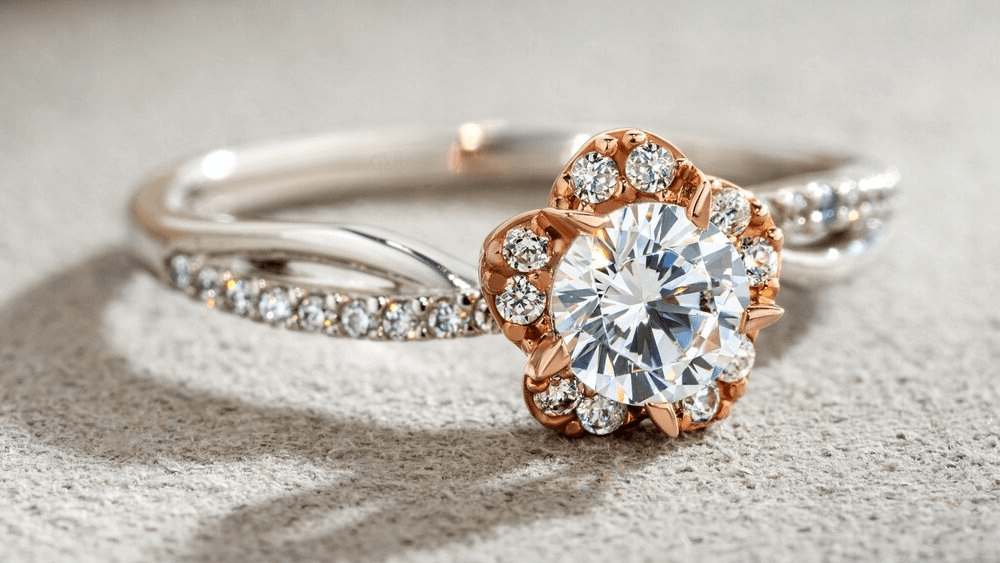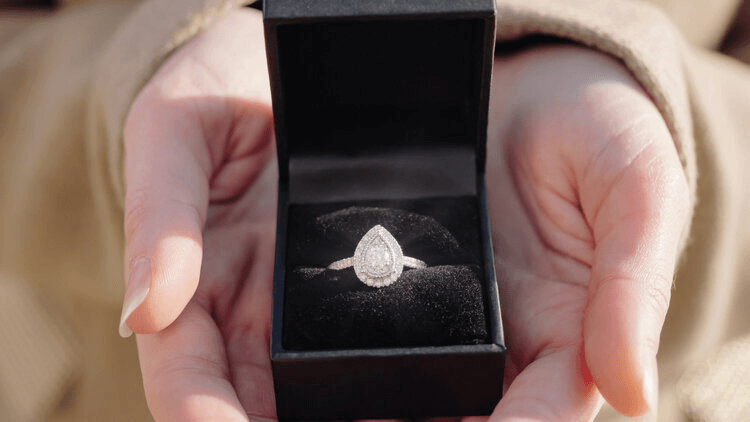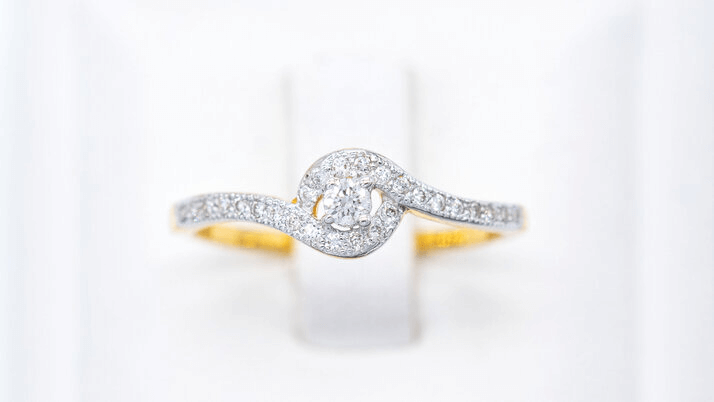Mastering the Art of Prong Setting Types: The Complete Guide

By Gary A.

Edited by Olivia H.
Published Mar 17, 2022
Edited on Dec 23, 2024
When it comes to achieving the perfect balance between security and style, mastering the art of prong setting types is essential to creating a timeless engagement ring that showcases your diamond’s brilliance.

Navigate this guide:
- 6 Quick Tips for Choosing Diamond Engagement Rings: Focus on Prong Setting Types
- Introduction
- Claw vs Round Prongs
- Petal Prongs
- V-Shaped Prongs
- ‘Tab’ or Flat Prongs
- Engagement Ring Maintenance Tips
- Our Expert Take
- 7 FAQs
Before we dive deeper into the specifics, here are some practical tips to help guide your decision-making process:
6 Quick Tips for Choosing Diamond Engagement Rings: Focus on Prong Setting Types
- Tip 1: Assess Prong Quantity and Placement: Generally, more prongs offer better security, but fewer prongs may enhance diamond visibility. For instance, 6 prongs offer more protection than 4. Check prong placement: Ensure prongs are evenly spaced and securely grip the diamond without obscuring key facets.
- Tip 2: Evaluate Prong Shape and Style: Different shapes like round, claw, V-shaped, and tab prongs influence both aesthetics and diamond safety. Choose one that complements your diamond’s cut and ring design. Consider style variations: Unique designs like double or petal prongs can add a distinctive look to your ring. Ensure these styles still provide ample security.
- Tip 3: Inspect Prong Quality and Craftsmanship: Prongs should be evenly sized and smoothly finished to prevent snagging on fabric. Check for metal strength: Ensure the prongs are made from durable metals like platinum or white gold for long-lasting wear.
- Tip 4: Consider Prong Height and Accessibility: Higher prongs elevate the diamond for prominence but may be prone to snagging. Lower settings are safer but less conspicuous. Ensure easy cleaning access: Choose prongs that allow for easy cleaning of the diamond, maintaining its brilliance.
- Tip 5: Analyze Prong Compatibility with Diamond Size: Larger diamonds may require thicker or double prongs for better security, while smaller stones can be elegantly held with finer prongs.
- Tip 6: Factor in Lifestyle and Daily Wear: If you lead an active lifestyle, opt for prong settings that offer security and are less likely to catch on objects.
Now that you’ve got these practical tips, use Jeweler AI below to find the perfect engagement ring that suits your style and budget:
Introduction
The process of picking out an engagement ring tends to start off with a focus on the bigger picture. Most people take on the task of finding a diamond, picking out a style of ring, a metal, and their accents before they ever start to home in on the smaller, finer details. It’s understandable – and, if you ask us, the best way to do it.
But, if you’ve made it this far, chances are you’re ready for some of the intricacies associated with creating a ring.

So, while your choice of prong may not have started out feeling like the most pressing concern, the time has come to focus all your attention on this tiny (though truly vital) bit of metalwork. Responsible not only for keeping your diamond central, but for keeping your diamond from disappearing between the floorboards, down a steam grate, or into that void between the platform and the subway, you’ve got to place a lot of faith into these little drops of metal.
Beyond the pragmatic, however, prongs can add a beautiful, complementary feature to your diamond, and reviewing all the options is the best way to ensure every element of your ring’s design is perfect.
Claw vs Round Prongs
Round Prongs
The classic design feature, round prongs offer little in the way of decoration, but they certainly do the job – and they do it discretely enough that the diamond is left as open to the air and light as possible.
Rings can feature four or six prongs – or more if you want to turn them into a design feature, rather than have them as nothing more than a technical requirement of the ring – and the number you settle on will depend on your own preferences. More prongs limit sparkle (though, admittedly, only marginally), while fewer prongs make the diamond slightly more vulnerable to chipping or falling out (though, once again, only marginally).
Round prongs are, as the name suggests, smoothly rounded – a little like a tiny drop of water. They create a small overlap at the diamond’s edge and, as with any prongs, conceal a small ‘groove’ that the diamond’s girdle sits within, to ensure a tight hold on the diamond.
Claw Prongs
Claw prongs bear a resemblance to round prongs, although they add a little flash of modernity to the design. As you can imagine, claws are slightly more elongated and pointed than round prongs. Shaped a little like canine teeth, they typically overlap the diamond a little more, but sit a little closer to ‘flush’ with the diamond’s surface.
Again, there’s no specific rule stating how many claws you need on your ring, although four typically remains the standard. Some designs utilize just three, but this is definitely a bigger risk – and, for obvious reasons, fewer than three is a definite no-go.
Since claws overlap the diamond a little more, four tends to be the favorable choice, or the diamond’s definition could risk being obscured.
Claw prongs look great alongside a knife-edge shank, which can mirror the edgier shape of the prongs for a wholly contemporary look.
If you’re particularly fond of the claw prong setting, then you might consider a double claw, which creates more of a focal point at the ring’s edge.
In general, they’re a little stronger than other prong types, simply because the nature of the design means that these prongs reach further over the diamond’s crown than, say, round prongs. The added security is relatively minimal, and you don’t need to feel as though the claw prong is the only safe option out there – but, if you’re a known worrier, then claw prongs might offer the extra security you need for your diamond.
Diamond Security
Round prongs are very secure. They have been used to keep countless diamonds safe on their owners’ fingers for generations, and shouldn’t be underestimated simply because they are small and unobtrusive. Sure, you’ll want to get your prongs checked over by a jeweler for early signs of wear – generally, every six months or so – but that’s no big deal, and doesn’t necessarily mean your prongs are wearing themselves out.
Round Prongs Pros: classic, unobtrusive, and very secure.
Round Prongs Cons: some people will consider them a little ‘middle of the road’ since they’re the obvious choice – particularly for the traditional solitaire.
Claw Prongs Pros: a little edgier and more modern than round prongs – and particularly striking in a contrasting metal, like rose or yellow gold. Plus, they’re very secure.
Claw Prongs Cons: typically, they do cover a little more of the diamond, simply because of their elongated shape.

Petal Prongs
For something that adds an extra element to the center setting without overwhelming the diamond in metalwork or accent stones, petal prongs are a great choice. From the face-up view, these prongs look practically indistinguishable from traditional, round prongs but, from the side view, you’ll notice a distinctly floral look.
A petal prong is created using two separate pieces of metal, set in a petal-like shape, which join at the top and create a single prong. It’s a little like a basket setting, but with that distinctly floreated silhouette that enhances the diamond, rather than competing with it.
Keep in mind that, to realize the full potential of the prong shape, it’s typically the case that these designs will feature six to eight prongs, rather than four.
Pros: one of the best ways to make a real feature out of your ring’s prongs, and a great touch for anyone with a feminine, floral style.
Cons: not quite as subtle as the more traditional options, so don’t consider it if you’re looking to keep the ring’s design minimalistic or streamlined.
V-Shaped Prongs
V-shaped or V-prongs are used to protect the corners of a diamond. Princess and Marquise cuts, along with Pears and Hearts, all feature delicately pointed corners that can be vulnerable to chipping or breaking during usual wear.
The best way to protect against this is to place a prong over the vulnerable corner, in order to prevent it from getting knocked or scraped.
For a lot of shoppers, this can feel like a setback, since covering the corner with a rounded prong inevitably obscures the sleek, sharp shape of the diamond.
V-shaped prongs form a right or acute angle that perfectly mirrors the original shape of the corner or point while offering an excellent level of protection against the outside world. The effect is a little like a very small open bezel, although it leaves plenty of the diamond open to the light.
A V-prong is a little more obvious than a subtle round prong, and, in the case of shapes that feature a combination of curves and points (like the Pear), you will have to combine a v-prong with another type of prong.
Pros: modern and sleek, the v-prong accentuates the shape of the diamond while offering a strong protective layer between the diamond’s weak spots and the outside world.
Cons: not as subtle as some of the other options on this list, and can only be used exclusively on symmetrical shapes like the Princess.
‘Tab’ or Flat Prongs
Flat prongs are a lot less conventional than round or claw prongs, but they’re a great, contemporary alternative that can prove a lot easier to wear – and, at the same time, offer a great contrast in shape to the softer cuts like the Round Brilliant and Oval.
Flat prongs behave like any other prongs but, even more so than claws, sit a lot closer to flush with the diamond’s crown. While still offering a lot of strength, flat prongs appear a lot thinner.
They can appear a little like tiny leaves curling over a flower bud, or they can appear a lot more modern and geometric, depending on the rest of the ring’s design.
A jeweler can use a special file to gradually smooth out a prong. Some people choose to have this done after the ring has already been made since it can help minimize any snagging that the wearer is experiencing.
Pros: great at protecting the diamond’s girdle, and avoiding any annoying snags against clothing. It’s a good alternative to a bezel if you like the vibe of the setting, but don’t want to cover too much of the diamond against the light.
Cons: The angular shape they create can look at odds with some diamond shapes, but this depends on how the individual ring is designed. For instance, four straight, square tab prongs on a Round Brilliant may create a more angular illusion – or conceal a Cushion’s characteristic, round corners.
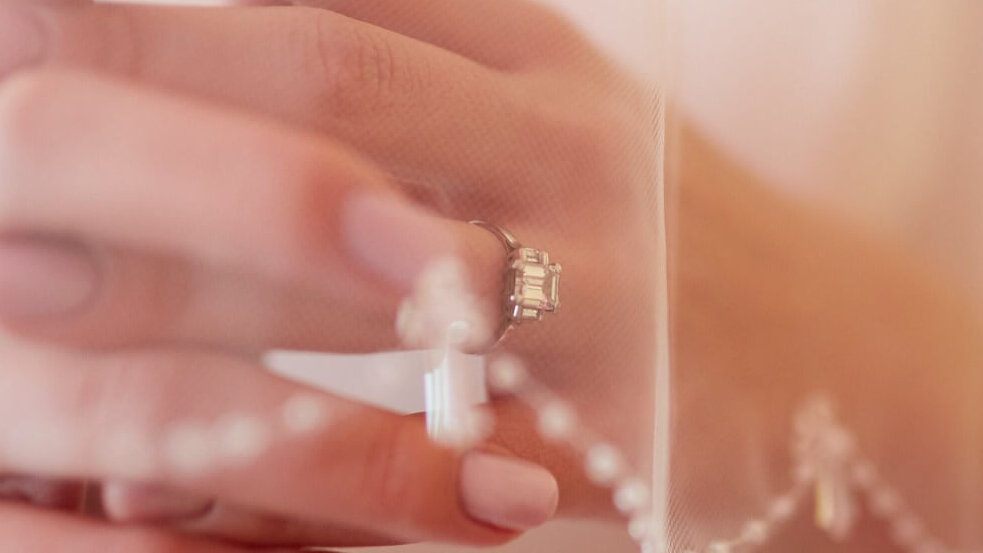
Engagement Ring Maintenance Tips
A ring’s prongs are a lot stronger than they look, but, even so, they do require semi-regular check-ups with an experienced jeweler to ensure they haven’t shifted. Without those checks, you could risk losing your diamond.
The jeweler will also be able to give the ring a good clean, removing more stubborn dirt and oil that you can’t clean off yourself at home. You can find out more about regular ring maintenance here.
Our Expert Take
Your ring’s prongs might not be at the very top of your list of priorities when you first start out looking at engagement rings. After all, in a lot of designs, the aim is to minimize their impact on the diamond as much as possible – to limit the extent to which we notice them, and encourage us to ‘overlook’ their existence altogether.
There’s nothing wrong with that and, for a lot of people, that will be the aim of the game. Some people choose to combine white gold or platinum prongs with a yellow gold shank, for instance, in the hope of camouflaging the prongs against the white of the diamond.
For others, however, the prongs themselves offer a great extra detail – and a good complement for the diamond. The popularity of the famous Tiffany setting from world-renowned jeweler Tiffany & Co., for instance, is a testament to the fact that prongs can – and frequently are – seen as one of the best aspects of a ring’s design.
As always, it all comes down to personal preference – what you think will complement your diamond the most, and what you think your partner will prefer to see when you pull back the lid of the ring box and pop the question.
7 FAQs
- Q: What Are the Most Secure Types of Prong Settings?
A: Six-prong settings and V-shaped prongs are generally considered the most secure, especially for protecting the corners of certain diamond shapes like princess or marquise cuts. - Q: How Do Different Prong Shapes Affect a Ring’s Appearance?
A: Claw prongs offer a modern look, round prongs are classic and unobtrusive, while unique shapes like tulip or petal prongs add decorative flair. - Q: Can I Change the Prong Style on My Existing Ring?
A: Yes, it’s often possible to modify prong styles, but it requires professional jewelry expertise to ensure the diamond’s security is maintained. - Q: Is There a Preferred Number of Prongs for Optimal Security?
A: Typically, six prongs offer more security than four, but the choice may also depend on the diamond’s size and shape. - Q: Do Prong Settings Require Special Care or Maintenance?
A: Yes, regular inspections are recommended to ensure prongs haven’t loosened or worn down, which can compromise diamond security. - Q: Are There Prong Styles Better Suited for Active Lifestyles?
A: Lower profile settings like tab prongs or styles with more prongs are generally better for active lifestyles as they reduce the risk of snagging. - Q: Does the Metal Choice for Prongs Matter?
A: Yes, metals like platinum and white gold are recommended for their strength and durability in holding the diamond securely.
Explore the perfect prong settings for your dream ring with Jeweler AI. Discover tailored options that match your style and preferences effortlessly!
FOLLOW-UP GUIDE SERIES





